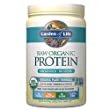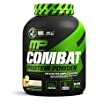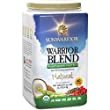In parts one and two of this 3 part series, I covered some of the more popular proteins like whey and soy. I will cover some of the more obscure protein powders this this third and final part. In addition I will cover a few of the blends that combine proteins from different sources.
In case you want to go back and check out part one or part two you can click on the links below. If not, keep reading.
Click here for protein powders part one
Click here for protein powders part two
Pea Protein
One of the lesser known protein powders comes from the Pisum sativum or yellow pea. This is a legume which is similar to the green pea and actually contains a lot of protein.
So why would someone opt for pea protein instead of one of the more popular proteins? The first reason would be a vegan diet where whey and casein are no-no’s. Another reason is because of a lactose intolerance which would also leave out those milk-base proteins.
After those two considerations there is still hemp protein left. The one advantage that pea protein powder has over hemp powder is the percent of calories from protein. Most hemp powders have around 50 or 60% of their calories coming from protein which is low for a protein powder. Most pea proteins are 80% or higher.
Even though peas have a lot of carbs in them, pea powders are pretty low in carbohydrates. Most of the powders have only one gram of carbohydrates.
The knock against pea protein is that although it is technically a complete protein because all essential amino acids are present, it has very low levels of the amino acids cysteine and methionine and high levels of the amino acid lysine.
Pea protein is usually combined with rice protein because of this. The protein from rice has a great complimentary amino acid profile which means it has high levels of cysteine and methionine but low levels of lysine. There is some research that shows that the aminos do not need to be ingested at the same time to be available for muscle building though.
Another major consideration with pea protein is it’s digestion rate. Studies show that pea protein is considered a slow digesting protein. This means it may not be the best choice for a post workout shake.
That being said it does have a good digestion rate which means the body will absorb almost all of the protein that is digested.
What I recommend

The best pea protein powder that I looked at in terms of ingredients and the nutritional info is Now Foods Pea Protein. This one has 24 grams of protein per 120 calorie serving. This equates to 80% of the calories coming from protein. This was right around the norm for the pea protein powders that I reviewed.
The other thing I like about this product is the ingredient list has only one ingredient; 100% Pure, Non-GMO Pea Protein. This was for the plain flavor though. They also make a chocolate and a vanilla flavor which has a bunch of additional flavoring added to it. So it is up to you whether the taste or the purity of the product is more important.
They do have a chocolate and vanilla flavor that does have other ingredients and sweeteners though. The main sweeteners for their flavored products is stevia. Like with the other powders, it will be up to you if the flavor is more important or the fewest additives.
Rice Protein
Like pea protein, rice protein is not very widely used or marketed. It is another plant-based protein that can be used as an alternative to the popular milk-based proteins.
Just like with pea protein, rice has a lot of carbs in it’s natural form but enzymes are able to separate the protein and carbohydrates. This gives rice protein very low carbs. Rice does not have a lot of fat so the most powders are also low in fat.
As mentioned previously rice protein is high in the amino acids cysteine and methionine but low in the amino acid lysine. This combines perfectly with the amino acid profile in pea protein which has a great inverse amino relationship.
Although I have not personally tried any rice protein powders, most people report that is has a very strong rice flavor. This can be good or bad depending on your taste preferences. Most reviews that I have seen about the texture report it as being very chalky. Like taste, this can be a positive or negative depending on your taste buds.
What I would choose
Most of the rice protein powders out there are combined with other proteins to give it a better amino profile. There are not a lot of pure rice protein powders out there for me to review. The best one that I saw was Nutribiotic Organic Rice Protein.
The good thing about this brand is that there is one ingredient in the ingredient list. It is the protein from brown rice and that’s it. In my opinion, the fewer ingredients a product has, the better.
There is only 12 grams of protein per serving, but the serving size is only a tablespoon which is only about half of what the normal serving size is for most powders. This means a comparable serving size would give you about 24 grams of protein.
The calories from protein is 80% which is another good thing. There is not fat and only 2 grams of carbs per serving.
I like the nutritional profile of this product a lot. The only drawback would be the lacking amino profile. This can be solved though with some legumes to give you the deficient lysine in this protein. The previously mentioned pea protein would also work. Again, the balancing aminos do not need to be ingested at the same time.
Time-Release Protein Powders
The time-release powders are actually a combination of a few different powders. Most of them combine the fast absorption of whey with the slow absorption of casein. This provides the benefit of an amino level spike from the whey and a steady amino release from the casein.
The quick acting amino spike is really good for right after your workout to help with the recovery process. This is the main reason that people use whey more than any other protein. Anabolic is a term that describes building muscle and whey is known as an anabolic protein.
The slow absorption of casein is beneficial for many other times of the day. The steady stream of aminos helps so that the body does not break down your muscle as quickly. Catabolic is a term that describes the breakdown of muscle and casein is usually described as an anti-catabolic protein.
Some of the other proteins that are in some of the time-released powders include egg protein, beef protein and soy protein (which I would avoid at all costs.) Some of the powders will add aminos, digestive enzymes and/or medium chain triglycerides. All of which provide some benefit to the muscle building process.
What are these for?
These time-release formulas seem like you get the best of both worlds. Because it has the quick absorption they can be used for a post workout. Because it has the slow absorption, they can also be used for a meal replacement.
Personally, I think as a meal replacement is where the real benefits of these time-released powders are. For post workouts I still like using a whey, then getting a real meal within about an hour. If that is something that is tough for you because of your schedule or whatever, these time-release proteins are a good alternative.
Watch out for
The use of a Caseinate. This is a casein protein that can come in the form of calcium caseinate or sodium caseinate. Basically this is just a different method that is used to extract the casein protein using enzymes. The better quality casein is micellar casein.
Digestibility comes into play here. Caseinates are more soluble so they are more easily digested. This means they will be absorbed quicker. There are even some studies that show that some caseinates will be absorbed as quick as whey. This can really be counterproductive if you are looking for something that will be absorbed slowly.
Micellar casein is a higher quality casein that is less soluble. This means the body will have a much tougher time digesting it so the aminos will be absorbed much slower. This is exactly what you want to happen with a time-release protein.
So just like with the other protein powders read the label so you know what you are getting and make sure what you are getting is in line with your goals.
What recommendations do I have?
When I look at a protein powder there are a few things that I look for. My criteria includes cost, quality of ingredients, lack of fillers, and the nutritional info (which includes the percentage of calories from protein.) Taste and mixability are lower on my list of priorities. Based on that, there was one product in this category that stood out from the rest.
In my opinion the best time-released powder is MusclePharm: Combat Powder. The first thing that I noticed is that it included all 3 types of whey (WPC, WPI and WPH.) This is a plus because even these wheys absorb at different rates.
The other types of protein on the label are Micellar Casein and Egg White Albumen. The casein gives the slow release and the egg white is a medium release with a good amino profile. All the bases seem to be covered and it does use micellar casein instead of one of the cassienates. This is another good thing.
The cost isn’t too bad for the serving size. This one isn’t perfect though. It does have some artificial flavors and sweeteners. Acesulfame Potassium, Sucralose, and Potassium Citrate are listed as the sweeteners and as with most food items the artificial flavors are not listed.
It’s label also lists some amino acids like glutamine, leucine and valine as well as the digestive enzymes protease and lactase.
The percent of calories from protein is also a little low. It is only at 71%, but based on the other percentages in this category, that low number is actually one of the higher ones.
Like with most brands of protein, pay attention to the flavor you get. Other flavors of this same product include ingredients like high fructose corn syrup, enriched flour, soybean and/or canola oil.
The other product that I really like in this category was Body Nutrition: Trutein. This one also uses whey, casein and egg proteins. It also has the protease digestive enzyme. It does not have the added aminos though but that should not be too much of an issue.
The whey in Truetein is both concentrate and isolate and the casein is micellar so the protein looks pretty good. The percent of calories from protein is at a good 83% so that is an advantage that Truetien has over Combat powder. They both have 25 grams of protein per serving so it’s not that much of an advantage.
The other thing that Truetein has is some added fiber. This helps with digestion. It also has some Omega-3s which are good for fat and cholesterol levels.
The ingredient list for this one looks pretty good as well. There aren’t any red flag ingredients. The sweeteners for this powder are Acesulfame Potassium and Sucralose.
Blended Vegan Powders
The last type of powder in this series is the category of powders that blend a few different types of plant-based proteins together. While the time-released proteins blend the protein because of their digestion rates, the vegan powders do the blending mainly because of the different amino profiles of their protein sources.
There are some exceptions but most plant-based proteins are not complete, which means that the essential amino acids are not present in the correct ratios for protein synthesis (muscle building.) The previous example was the protein from both rice and peas.
These would be a good choice for vegans and vegetarians but may also be suitable for non-vegetarians that have digestive issues. These blended proteins have the complete protein that can be easier to process for some people.
The price per pound is a little more expensive with these vegan powders but the serving size is smaller than most wheys. The price per serving is still a bit more expensive though. This can be a limiting factor for some but if you are a vegan the sources of protein are a lot less so this is an easy option.
Buyer Beware of…
Fructose is an ingredient that I see in a lot of these powders as it’s sweetener. This would be the red flag ingredient that I would avoid. Fructose can only be processed in the liver and has been shown to increase the risk of heart disease, diabetes and other chronic diseases. It is also very easily stored as fat.
Click here to learn more about the dangers of fructose
If protein powder is your only source of protein, you would definitely want something without fructose to minimize your intake. Fructose also interferes with your brain’s communication with the hormone leptin which can lead to overeating. This can be very detrimental if you are cutting.
My recommendation
Since there are not a lot of quality vegan products out there without fructose as it’s sweetener the list I had to choose from was small. The best of this small list is the Sunwarrior Warrior Blend Protein.
The sources of protein are pea, cranberry and hemp. As discussed previously hemp is a complete protein source. While the amino profile does not look exactly like an egg it does look pretty good giving it a good biological value.
The only other ingredient in the natural flavor is medium chain triglycerides (MCT.) This is an ingredient that is becoming more and more popular in protein powders. These MCTs help with digestion, satiety and can help fat loss.
They do have a chocolate and vanilla flavor that has other flavorings and uses stevia as it’s sweetener. None of the other ingredients raise any red flags for me so they are all good from an ingredient standpoint.
The percent of calories from protein is only 76% but for this category of powders it’s actually pretty good. There are 19 grams of protein per serving.

Another brand that looked pretty good was Garden of Life Raw Organic Protein. This one has a massive amount of protein sources. They are all organic according to it’s label.
The protein sources are sprouted brown rice, amaranth sprout, quinoa sprout, millet sprout, buckwheat sprout, garbanzo bean sprout, lentil sprout, adzuki bean sprout, flax seed sprout, sunflower seed sprout, pumpkin seed sprout, chia seed sprout and sesame seed sprout. That is definitely the longest list of protein sources that I have seen in a single powder.
It’s protein is only 17 grams per serving but 85 percent of it’s calories are from protein which is a high level for any protein powder.
The other ingredients include brewer’s yeast and natto. Brewer’s yeast helps the body to use insulin more effectively and may help to reduce blood sugar levels. Natto is soy that has been fermented. Because it is fermented a lot of the negative effects assorted with soy are significantly reduced.
Like the Sun Warrior protein, the Garden of Life protein comes in three flavors; natural, chocolate and vanilla. There are not sweeteners or flavorings in the natural flavor but the chocolate and vanilla use stevia for it’s sweetener.
So that is it for this series. If there is a protein type that I did not cover or if you have any questions on any of the proteins that I did cover, leave a comment below or on the facebook group. You can also subscribe to the email list so you know when new articles are posted. If you know someone that would benefit from this series you can also share this article on social media with any of the buttons below. Thanks for reading.





